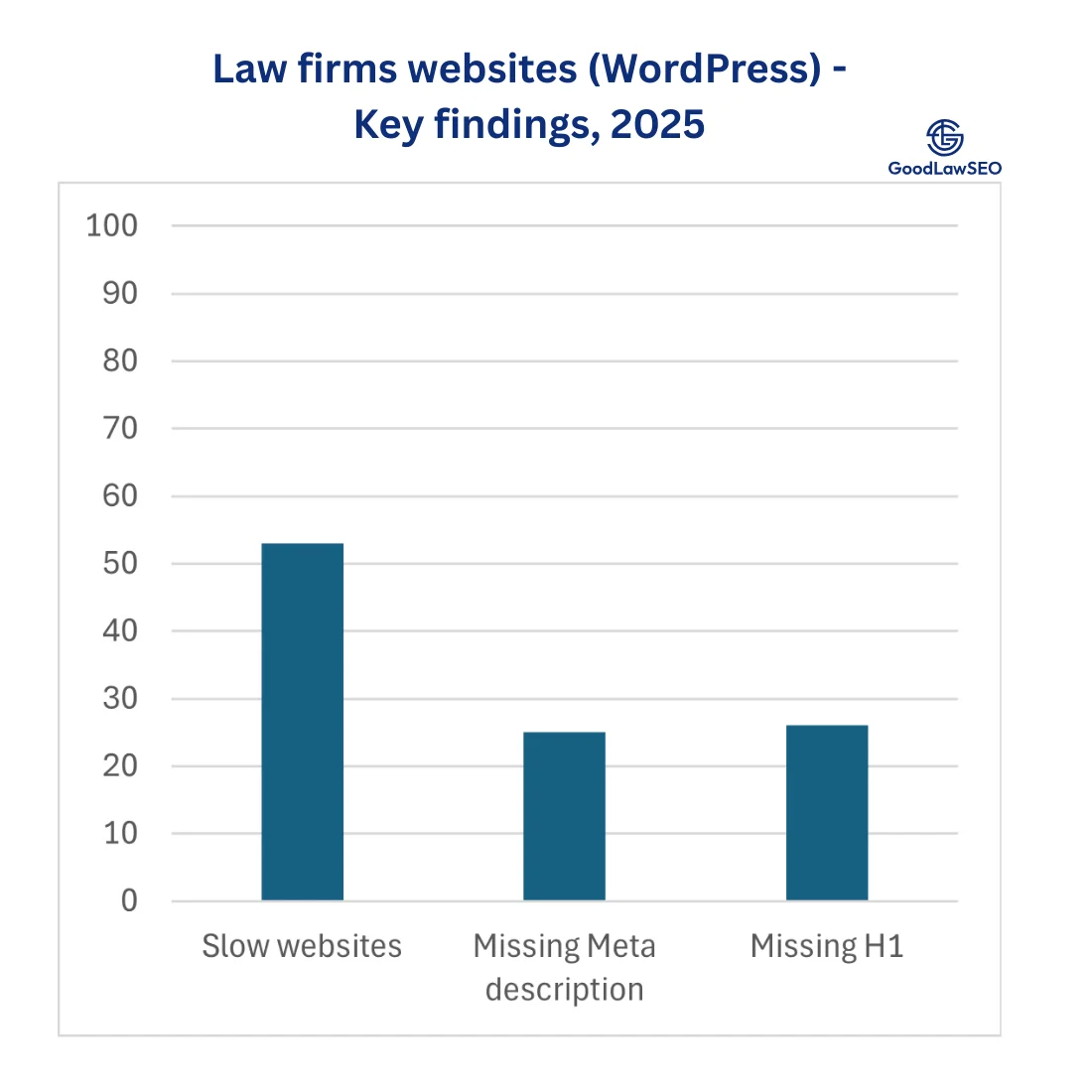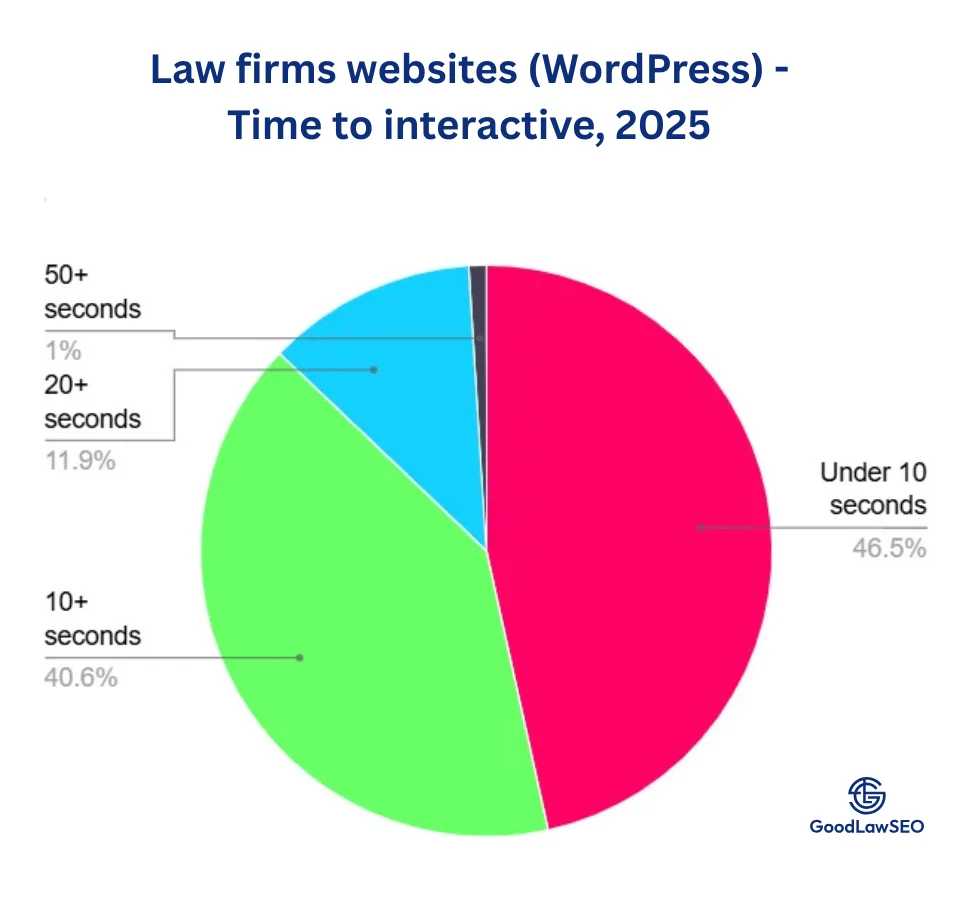Personal Injury Law Firms – Website Performance Study, 2025
The US legal market is fiercely competitive—the fight for quality personal injury cases has never been more intense. You'd expect law firms to push their marketing efforts to the absolute limit, especially when it comes to their website's appearance and performance. After all, your website is often a potential client's first impression of your firm's competence and professionalism.
Yet what we've observed over the years tells a different story. We've seen well-established personal injury firms running websites that look like they haven't been updated since 2010—slow, clunky, and frankly unprofessional. It's puzzling, especially in a field where first impressions can make or break a case referral.
This disconnect between offline status and online presence prompted us to dig deeper. What we discovered in our comprehensive study of nearly 4,000 personal injury law firm websites might surprise you—and it definitely should concern you if you're serious about competing in today's digital marketplace.
We went through 4,850 US personal injury law firm websites across all 50 states and analysed their important metrics—we wanted to see the big picture. Our comprehensive analysis reveals critical performance issues that directly impact client acquisition and retention. With 82% of these firms using WordPress, we focused on them. We identified widespread technical and content deficiencies that negatively affect user experience and search visibility.
Key findings:
- 82% of the law firm websites are built on WordPress
- 53% of these WordPress sites have critically slow loading times
- 25% lack basic SEO elements like meta descriptions
- 26% are missing primary H1 headings on their homepage
- Several sites were compromised with malicious content
These issues translate directly to lost clients and revenue in a highly competitive market.

Methodology
Our research team collected all US personal injury law firm listings from Justia directories across all 50 states in the USA, resulting in 4,850 unique websites. We identified 3,980 WordPress sites (82% of the total) and conducted comprehensive technical and content analysis using specialized auditing tools.
We measured:
- Core Web Vitals and other speed metrics
- Content structure and SEO fundamentals
- Mobile optimization
- Security vulnerabilities
Speed Analysis: The Client Conversion Killer
Our speed analysis (mobile versions) revealed concerning statistics:

More than 53% of the 3,900+ law firm websites we tested took over 10 seconds to become interactive—this is the time it takes before a user can even scroll, click, or tap anything on your site. In an industry this competitive, this finding was genuinely shocking.
What makes this even more mind-blowing is the disconnect with law firms' marketing investments. We know personal injury firms spend enormous amounts on digital advertising—with Google Ads clicks often costing $100, $200, or even more per click to bring a potential client to their website. Yet nearly half of these expensive visitors land on slow, unoptimized pages that frustrate them into hitting the back button and choosing a competitor instead.
Think about it: you're paying premium rates to get injured clients to your website, only to lose them because your site takes too long to load. It's like spending thousands on a prime billboard location, then posting a faded, illegible sign. The math simply doesn't add up.
This represents a massive opportunity cost for firms struggling to keep their case pipeline full. Every slow-loading page is money walking out the door to competitors who've invested in proper website performance.
Content and SEO Fundamentals: Missing the Basics
Of the 3,139 law firm WordPress sites where we managed to retrieve content data:
- 791 sites (25%) completely lack meta descriptions
- 804 sites (26%) have no H1 heading on their homepage
These fundamental SEO elements are like having a business card without your name or services listed.
To me, this is a clear signal that a quarter of all law firms are not doing any SEO work on their websites. So many lawyers have shared with me they don't really trust SEO (because of the bad experience they've had with shady SEO agencies before) but nevertheless, SEO must not be neglected - without these SEO basics, your firm's visibility in search results is severely compromised.
Security Concerns: Reputation at Risk
Our analysis uncovered multiple compromised websites still listed in Justia directories. These sites contained:
- Foreign language spam content
- Redirects to gambling and casino sites
- Potential malware
A compromised website not only loses clients but actively damages your firm's reputation and trustworthiness.
Why This Matters: The Financial Impact
Lost Clients = Lost Revenue
You know how competitive is the personal injury law industry. Missing a new client opportunity is not an option. And yet, when potential clients visit a slow or poorly optimized website:
- They leave before engaging: Studies show 53% of mobile users abandon sites that take longer than 3 seconds to load.
So you paid $100 for a Google Ads click, got that person looking for a personal injury lawyer landing on your page and, because it was slow, they clicked back and went on to the next one. Well, you just lost the client you wanted... and a hundred dollar bill. - They choose competitors: Not only you lost a potential client, but you sent them to your competitors. How do you like this?
- Search engine penalties: Google's Core Web Vitals are now ranking factors. Poor performance means lower rankings and fewer organic clients, respectively higher cost per acquisition.
For a personal injury law firm, where a single case can be worth tens of thousands of dollars, every lost visitor represents potential lost revenue.
The Personal Injury Client Journey
When someone is injured and seeking legal help, their online journey typically follows this path:
- Immediate Search: Often from a mobile device, potentially at a hospital or while recovering
- Quick Evaluation: They'll visit multiple law firm websites in rapid succession
- Speed-Based Decision: Sites that load quickly and provide clear information gain advantage
- Immediate Action: They'll contact firms that establish trust through professional presentation
Slow, poorly optimized websites interrupt this journey at the most critical moment—when a potential client is actively seeking help.
Recommendations for Law Firm Website Owners
- Conduct a technical audit
- Evaluate your page speed scores using Google PageSpeed Insights
- Check for basic SEO elements including meta descriptions and proper heading structure
- Verify security with regular malware scans
- Optimize for speed
- Compress and properly size images
- Minimize render-blocking resources
- Implement browser caching
- Consider performance-focused hosting
- Fix SEO fundamentals
- Create unique, compelling meta descriptions
- Implement proper heading structure with clear H1 tags
- Optimize content for relevant keywords
- Implement security measures
- Keep WordPress core, themes, and plugins updated
- Use security plugins
- Implement regular backup solutions
Conclusion
In the highly competitive personal injury law market, your website is often your first opportunity to demonstrate competence to potential clients. Technical issues, slow loading times, and poor SEO fundamentals are actively costing firms clients and cases.
The good news? Most of these issues are readily fixable with proper expertise. Firms that address these concerns now will gain competitive advantage in an increasingly digital-first legal marketplace.
This study was conducted in early 2025 by GoodLawSEO. We specialize in WordPress optimization and SEO for small to medium law firms. To find out if your website is on the Good Law SEO side, get in touch.